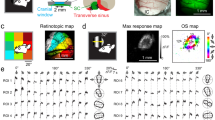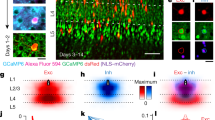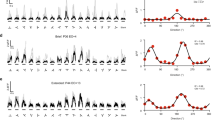Abstract
Here we explore inhibitory circuits at the thalamocortical stage of processing in layer 4 of the cat's visual cortex, focusing on the anatomy and physiology of the interneurons themselves. Our immediate aim was to explore the inhibitory mechanisms that contribute to orientation selectivity, perhaps the most dramatic response property to emerge across the thalamocortical synapse. The broader goal was to understand how inhibitory circuits operate. Using whole-cell recording in cats in vivo, we found that layer 4 contains two populations of inhibitory cells defined by receptive field class—simple and complex. The simple cells were selective for stimulus orientation, whereas the complex cells were not. Our observations help to explain how neurons become sensitive to stimulus orientation and maintain that selectivity as stimulus contrast changes. Overall, the work suggests that different sources of inhibition, either selective for specific features or broadly tuned, interact to provide appropriate representations of elements within the environment.
This is a preview of subscription content, access via your institution
Access options
Subscribe to this journal
Receive 12 print issues and online access
$209.00 per year
only $17.42 per issue
Buy this article
- Purchase on Springer Link
- Instant access to full article PDF
Prices may be subject to local taxes which are calculated during checkout








Similar content being viewed by others
References
Martin, K.A., Somogyi, P. & Whitteridge, D. Physiological and morphological properties of identified basket cells in the cat's visual cortex. Exp. Brain Res. 50, 193–200 (1983).
Azouz, R., Gray, C.M., Nowak, L.G. & McCormick, D.A. Physiological properties of inhibitory interneurons in cat striate cortex. Cereb. Cortex 7, 534–545 (1997).
Buzas, P., Eysel, U.T., Adorjan, P. & Kisvarday, Z.F. Axonal topography of cortical basket cells in relation to orientation, direction, and ocular dominance maps. J. Comp. Neurol. 437, 259–285 (2001).
Thomson, A.M. & West, D.C. Presynaptic frequency filtering in the gamma frequency band; dual intracellular recordings in slices of adult rat and cat neocortex. Cereb. Cortex 13, 136–143 (2003).
Hubel, D.H. & Wiesel, T.N. Receptive fields, binocular interaction and functional architecture in the cat's visual cortex. J. Physiol. (Lond.) 160, 106–154 (1962).
Sclar, G. & Freeman, R.D. Orientation selectivity in the cat's striate cortex is invariant with stimulus contrast. Exp. Brain Res. 46, 457–461 (1982).
Ohzawa, I., Sclar, G. & Freeman, R.D. Contrast gain control in the cat's visual system. J. Neurophysiol. 54, 651–667 (1985).
Bruno, R.M. & Simons, D.J. Feedforward mechanisms of excitatory and inhibitory cortical receptive fields. J. Neurosci. 22, 10966–10975 (2002).
Swadlow, H.A. & Gusev, A.G. Receptive-field construction in cortical inhibitory interneurons. Nat. Neurosci. 5, 403–404 (2002).
Swadlow, H.A. Fast-spike interneurons and feedforward inhibition in awake sensory neocortex. Cereb. Cortex 13, 25–32 (2003).
Lund, J.S., Henry, G.H., MacQueen, C.L. & Harvey, A.R. Anatomical organization of the primary visual cortex (area 17) of the cat. A comparison with area 17 of the macaque monkey. J. Comp. Neurol. 184, 599–618 (1979).
Gabbott, P.L. & Somogyi, P. Quantitative distribution of GABA-immunoreactive neurons in the visual cortex (area 17) of the cat. Exp. Brain Res. 61, 323–331 (1986).
Callaway, E.M. Local circuits in primary visual cortex of the macaque monkey. Annu. Rev. Neurosci. 21, 47–74 (1998).
Gilbert, C.D. Laminar differences in receptive field properties of cells in cat primary visual cortex. J. Physiol. (Lond.) 268, 391–421 (1977).
Bullier, J. & Henry, G.H. Ordinal position of neurons in cat striate cortex. J. Neurophysiol. 42, 1251–1263 (1979).
Tanaka, K. Organization of geniculate inputs to visual cortical cells in the cat. Vision Res. 25, 357–364 (1985).
Jones, J.P. & Palmer, L.A. The two-dimensional spatial structure of simple receptive fields in cat striate cortex. J. Neurophysiol. 58, 1187–1211 (1987).
Ferster, D. Orientation selectivity of synaptic potentials in neurons of cat primary visual cortex. J. Neurosci. 6, 1284–1301 (1986).
Ferster, D. & Miller, K.D. Neural mechanisms of orientation selectivity in the visual cortex. Annu. Rev. Neurosci. 23, 441–471 (2000).
Hirsch, J.A. et al. Synaptic physiology of the flow of information in the cat's visual cortex in vivo. J. Physiol. (Lond.) 540, 335–350 (2002).
Reid, R.C. & Alonso, J.M. Specificity of monosynaptic connections from thalamus to visual cortex. Nature 378, 281–284 (1995).
Hirsch, J.A., Alonso, J.M., Reid, R.C. & Martinez, L.M. Synaptic integration in striate cortical simple cells. J. Neurosci. 18, 9517–9528 (1998).
Borg-Graham, L.J., Monier, C. & Fregnac, Y. Visual input evokes transient and strong shunting inhibition in visual cortical neurons. Nature 393, 369–373 (1998).
Wielaard, D.J., Shelley, M., McLaughlin, D. & Shapley, R. How simple cells are made in a nonlinear network model of the visual cortex. J. Neurosci. 21, 5203–5211 (2001).
Monier, C., Chavane, F., Baudot, P., Borg-Graham, L.J. & Fregnac, Y. Orientation and direction selectivity of synaptic inputs in visual cortical neurons: a diversity of combinations produces spike tuning. Neuron 37, 663–680 (2003).
Burr, D., Morrone, C. & Maffei, L. Intra-cortical inhibition prevents simple cells from responding to textured visual patterns. Exp. Brain Res. 43, 455–458 (1981).
Sillito, A.M. GABA mediated inhibitory processes in the function of the geniculo-striate system. Prog. Brain Res. 90, 349–384 (1992).
Somers, D.C., Nelson, S.B. & Sur, M. An emergent model of orientation selectivity in cat visual cortical simple cells. J. Neurosci. 15, 5448–5465 (1995).
Troyer, T.W., Krukowski, A.E., Priebe, N.J. & Miller, K.D. Contrast-invariant orientation tuning in cat visual cortex: thalamocortical input tuning and correlation-based intracortical connectivity. J. Neurosci. 18, 5908–5927 (1998).
Ringach, D.L., Hawken, M.J. & Shapley, R. Dynamics of orientation tuning in macaque V1: the role of global and tuned supression. J. Neurophysiol. 90, 342–352 (2003).
Troyer, T.W., Krukowski, A.E. & Miller, K.D. LGN input to simple cells and contrast-invariant orientation tuning: an analysis. J. Neurophysiol. 87, 2741–2752 (2002).
Lauritzen, T.Z. & Miller, K.D. Different roles for simple- and complex-cell inhibition in V1. J. Neurosci. (in press).
Nowak, L.G., Azouz, R., Sanchez-Vives, M.V., Gray, C.M. & McCormick, D.A. Electrophysiological classes of cat primary visual cortical neurons in vivo as revealed by quantitative analyses. J. Neurophysiol. 89, 1541–1566 (2003).
Hirsch, J.A. Synaptic integration in layer IV of the ferret striate cortex. J. Physiol. (Lond.) 483, 183–199 (1995).
Gibson, J.R., Beierlein, M. & Connors, B.W. Two networks of electrically coupled inhibitory neurons in neocortex. Nature 402, 75–79 (1999).
Porter, J.T., Johnson, C.K. & Agmon, A. Diverse types of interneurons generate thalamus-evoked feedforward inhibition in the mouse barrel cortex. J. Neurosci. 21, 2699–2710 (2001).
Martinez, L.M., Alonso, J.M., Reid, R.C. & Hirsch, J.A. Laminar processing of stimulus orientation in cat visual cortex. J. Physiol. (Lond.) 321–333 (2002).
Hirsch, J.A. Synaptic physiology and receptive field structure in the early visual pathway of the cat. Cereb. Cortex 13, 63–69 (2003).
Schiller, P.H., Finlay, B.L. & Volman, S.F. Quantitative studies of single-cell properties in monkey striate cortex. I. Spatiotemporal organization of receptive fields. J. Neurophysiol. 39, 1288–1319 (1976).
Anderson, J., Carandini, M. & Ferster, D. Orientation tuning of input conductance, excitation, and inhibition in cat primary visual cortex. J. Neurophysiol. 84, 909–926 (2000).
Kayser, A.S. & Miller, K.D. Opponent inhibition: a developmental model of layer 4 of the neocortical circuit. Neuron 33, 131–142 (2002).
Volgushev, M., Pei, X., Vidyasagar, T.R. & Creutzfeldt, O.D. Excitation and inhibition in orientation selectivity of cat visual cortex neurons revealed by whole-cell recordings in vivo. Vis. Neurosci. 10, 1151–1155 (1993).
Henry, G.H. Receptive field classes of cells in the striate cortex of the cat. Brain Res. 133, 1–28 (1977).
Usrey, W.M., Sceniak, M.P. & Chapman, B. Receptive fields and response properties of neurons in layer 4 of ferret visual cortex. J. Neurophysiol. 89, 1003–1015 (2003).
Chisum, H.J., Mooser, F. & Fitzpatrick, D. Emergent properties of layer 2/3 neurons reflect the collinear arrangement of horizontal connections in tree shrew visual cortex. J. Neurosci. 23, 2947–2960 (2003).
Carandini, M., Heeger, D.J. & Senn, W. A synaptic explanation of suppression in visual cortex. J. Neurosci. 22, 10053–10065 (2002).
Gilbert, C.D. & Wiesel, T.N. Morphology and intracortical projections of functionally characterised neurones in the cat visual cortex. Nature 280, 120–125 (1979).
Moore, C.I., Nelson, S.B. & Sur, M. Dynamics of neuronal processing in rat somatosensory cortex. Trends Neurosci. 22, 513–520 (1999).
Brecht, M. & Sakmann, B. Dynamic representation of whisker deflection by synaptic potentials in spiny stellate and pyramidal cells in the barrels and septa of layer 4 rat somatosensory cortex. J. Physiol. (Lond.) 543, 49–70 (2002).
Skottun, B.C. et al. Classifying simple and complex cells on the basis of response modulation. Vision Res. 31, 1079–1086 (1991).
Acknowledgements
We thank T.N. Wiesel for discussions, K.D. Miller for improving the manuscript, R.C. Reid for contributing software and C.G. Marshall, K.D. Naik and J.M. Provost for assistance with the reconstructions. Supported by National Institutes of Health EY09593 to J.A.H.
Author information
Authors and Affiliations
Corresponding author
Ethics declarations
Competing interests
The authors declare no competing financial interests.
Supplementary information
Supplementary Fig. 1.
Responses to oriented bars for three additional simple and three additional complex cells. Each panel in a-f shows results from a single interneuron; simple cells (a-c), complex cells (d-f). For every cell, a contour plot of the receptive field is shown above averaged responses to variously oriented moving bars. In each column of records, the top trace depicts the response evoked by an optimally oriented bar; subsequent records show responses to bars tilted 22, 45, and 90° away from the preferred orientation. For the simple cell of panel a, an optimally oriented dark bar evoked a pattern of depolarization, hyperpolarization and depolarization as it crossed the Off, On and Off subregions. The response was similar at the near preferred angle and then diminished as the stimulus tilted towards the orthogonal orientation; similar patterns were seen in c for a cell whose receptive field also had three subregions. The records shown in b are from a cell whose receptive field has just two subregions. As a bright bar coursed over the On and Off subregions it first elicited a depolarization, then a hyperpolarization and finally a second depolarization on exit from the receptive field. For complex cells, (d-f), responses to the moving bars were similar at all orientations. Scale bars are 5 mV and 200 msec; all conventions as for figures in the text. A plot of the tuning curves for depolarization for all cells is shown in g; gray lines indicate curves for complex cells and black lines curves for simple cells. (JPG 43 kb)
Rights and permissions
About this article
Cite this article
Hirsch, J., Martinez, L., Pillai, C. et al. Functionally distinct inhibitory neurons at the first stage of visual cortical processing. Nat Neurosci 6, 1300–1308 (2003). https://doi.org/10.1038/nn1152
Received:
Accepted:
Published:
Issue Date:
DOI: https://doi.org/10.1038/nn1152
This article is cited by
-
Local origin of excitatory–inhibitory tuning equivalence in a cortical network
Nature Neuroscience (2024)
-
Translaminar circuits formed by the pyramidal cells in the superficial layers of cat visual cortex
Brain Structure and Function (2017)
-
Balance or imbalance: inhibitory circuits for direction selectivity in the auditory system
Cellular and Molecular Life Sciences (2015)
-
Orientation selectivity in cat primary visual cortex: local and global measurement
Neuroscience Bulletin (2015)
-
Biologically realistic excitatory and inhibitory cell properties emerge from a sparse coding network
BMC Neuroscience (2012)



